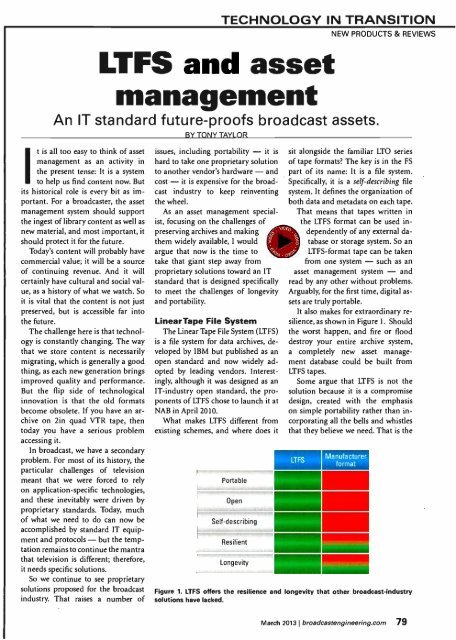ßroadcastEnsineerin - AmericanRadioHistory.Com
ßroadcastEnsineerin - AmericanRadioHistory.Com
ßroadcastEnsineerin - AmericanRadioHistory.Com
You also want an ePaper? Increase the reach of your titles
YUMPU automatically turns print PDFs into web optimized ePapers that Google loves.
TECHNOLOGY IN TRANSITION<br />
LTFS and asset<br />
management<br />
An IT standard future -proofs broadcast assets.<br />
NEW PRODUCTS & REVIEWS<br />
It is all too easy to think of asset<br />
management as an activity in<br />
the present tense: It is a system<br />
to help us find content now. But<br />
its historical role is every bit as important.<br />
For a broadcaster, the asset<br />
management system should support<br />
the ingest of library content as well as<br />
new material, and most important, it<br />
should protect it for the future.<br />
Today's content will probably have<br />
commercial value; it will be a source<br />
of continuing revenue. And it will<br />
certainly have cultural and social value,<br />
as a history of what we watch. So<br />
it is vital that the content is not just<br />
preserved, but is accessible far into<br />
the future.<br />
The challenge here is that technology<br />
is constantly changing. The way<br />
that we store content is necessarily<br />
migrating, which is generally a good<br />
thing, as each new generation brings<br />
improved quality and performance.<br />
But the flip side of technological<br />
innovation is that the old formats<br />
become obsolete. If you have an archive<br />
on tin quad VTR tape, then<br />
today you have a serious problem<br />
accessing it.<br />
In broadcast, we have a secondary<br />
problem. For most of its history, the<br />
particular challenges of television<br />
meant that we were forced to rely<br />
on application- specific technologies,<br />
and these inevitably were driven by<br />
proprietary standards. Today, much<br />
of what we need to do can now be<br />
accomplished by standard IT equipment<br />
and protocols - but the temptation<br />
remains to continue the mantra<br />
that television is different; therefore,<br />
it needs specific solutions.<br />
So we continue to see proprietary<br />
solutions proposed for the broadcast<br />
industry. That raises a number of<br />
BY TONY TAYLOR<br />
issues, including portability - it is<br />
hard to take one proprietary solution<br />
to another vendor's hardware - and<br />
cost - it is expensive for the broadcast<br />
industry to keep reinventing<br />
the wheel.<br />
As an asset management specialist,<br />
focusing on the challenges of<br />
preserving archives and making<br />
them widely available, I would<br />
argue that now is the time to<br />
take that giant step away from<br />
proprietary solutions toward an IT<br />
standard that is designed specifically<br />
to meet the challenges of longevity<br />
and portability.<br />
LinearTape File System<br />
The Linear Tape File System (LTFS)<br />
is a file system for data archives, developed<br />
by IBM but published as an<br />
open standard and now widely adopted<br />
by leading vendors. Interestingly,<br />
although it was designed as an<br />
IT- industry open standard, the proponents<br />
of LTFS chose to launch it at<br />
NAB in April 2010.<br />
What makes LTFS different from<br />
existing schemes, and where does it<br />
Portable<br />
Open<br />
Self- describing<br />
Resilient<br />
Longevity<br />
sit alongside the familiar LTO series<br />
of tape formats? The key is in the FS<br />
part of its name: It is a file system.<br />
Specifically, it is a self -describing file<br />
system. It defines the organization of<br />
both data and metadata on each tape.<br />
That means that tapes written in<br />
the LTFS format can be used independently<br />
of any external database<br />
or storage system. So an<br />
LTFS- format tape can be taken<br />
from one system - such as an<br />
asset management system - and<br />
read by any other without problems.<br />
Arguably, for the first time, digital assets<br />
are truly portable.<br />
It also makes for extraordinary resilience,<br />
as shown in Figure 1. Should<br />
the worst happen, and fire or flood<br />
destroy your entire archive system,<br />
a completely new asset management<br />
database could be built from<br />
LTFS tapes.<br />
Some argue that LTFS is not the<br />
solution because it is a compromise<br />
design, created with the emphasis<br />
on simple portability rather than incorporating<br />
all the bells and whistles<br />
that they believe we need. That is the<br />
LTFS<br />
Manufacturer<br />
format<br />
Figure 1. LTFS offers the resilience and longevity that other broadcast -industry<br />
solutions have lacked.<br />
March 2013 I broadcastengineering.com<br />
79
















